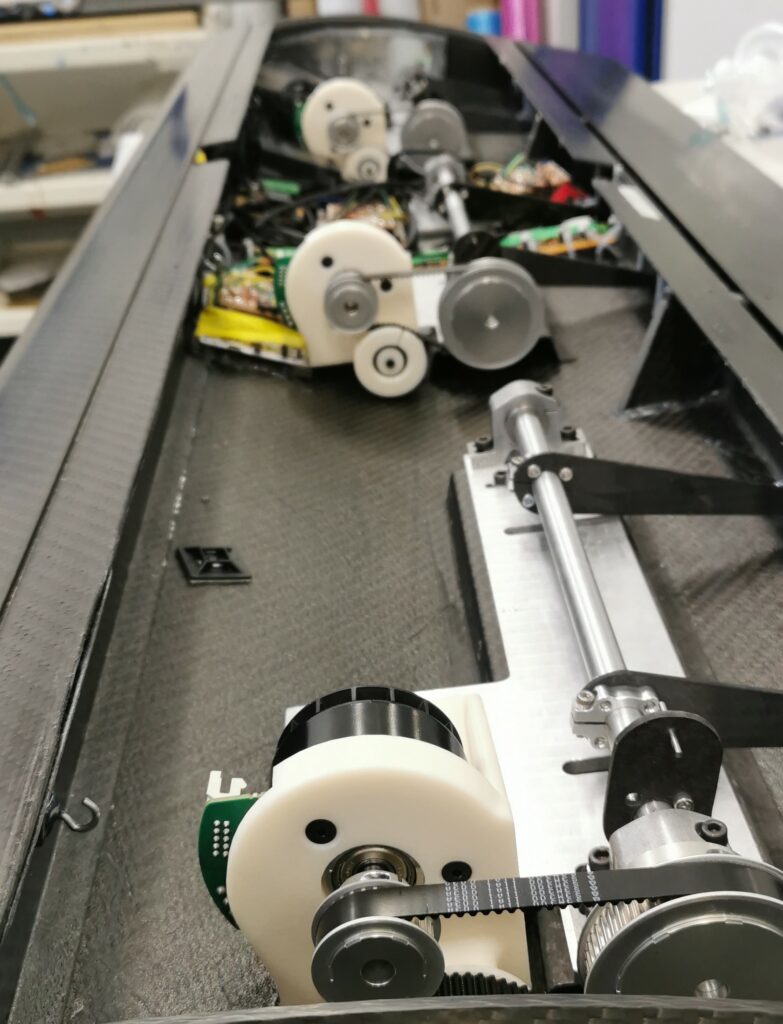Mini-spoiler alert for faster flight

Researchers at the University of Bath are investigating how deploying spoiler-like devices called mini-tabs could help electric aircraft fly faster (writes Nick Flaherty).
Mini-tabs can counteract the damaging vibrations caused by whirl flutter that occurs at high flight speeds. Maxon has provided the motion systems to test the effectiveness of the mini-tabs on a novel wind tunnel test rig.
Whirl flutter is an instability that occurs via elastically mounted propeller rotors, causing the entire wing-rotor system to vibrate. It kicks in when a critical speed, specific to the design of each individual aircraft, is reached. Beyond this speed, whirl flutter can create vibrations strong enough to shake the wing apart.
Current tilt-rotors typically use thick wing sections to increase the rigidity of the wing-rotor system and push whirl flutter to higher critical speeds. That though comes with a cost of increased structural weight and higher aerodynamic drag, so more power is needed to lift the aircraft vertically and to overcome aerodynamic drag in horizontal mode.
Active aerodynamic control devices can alter the wing loads in real time to counteract the vibrations. Such a control system would relax the need for thick wings and allow the aircraft to push past the critical speed where whirl flutter occurs.
The researchers, at the Institute for Propulsion and Mobility (IPM) at the University of Bath, have designed and built a wind tunnel to simulate whirl flutter vibrations to test aerodynamic control strategies
“Testing aerodynamic control strategies for whirl flutter is not a simple process,” said Dr Sam Bull, the lead researcher at the IPM. “Not only do we have to assess their performance across a wide range of deployment speeds, we also have to observe how that performance changes on a vibrating wing – similar to what would occur on a real aircraft undergoing whirl flutter.”
The mini-tab is a miniature spoiler that protrudes above and below the wing by up to 2% of the wing width – 10 mm in the experiments – to calm whirl flutter vibrations.
“On an aircraft, conventional control surfaces known as a flaperon or ailerons are deployed to change the loads around the wing,” said Dr Bull. “However, the size and weight of these control surfaces mean you can’t move them very fast. Mini-tabs, on the other hand, have a relatively low mass, meaning you can deploy them much faster, giving the potential to counteract the effect of whirl flutter.”
Powering the mini-tab is a Maxon EC 60 brushless 200 W motor with integrated Hall effect sensors for position feedback to support high-frequency operation with high precision and low latency.
The motion system is driven with both feedforward and feedback control. The combination of the two reduces lag time and helps oppose the acceleration effects of the wing vibrations, which would otherwise cause the mini-tab to drift from the intended deployment position.
“What we were most concerned about was accurate position feedback,” said Dr Bull. “We needed really clean feedback signals so we could achieve high positional accuracy at a given deployment frequency. The Maxon motion system gives us this performance.
“Our experimental pressure data shows that when you start deploying a mini-tab, it changes the pressure field around the entire wing. We already know you can use these devices to augment the pressure and loads around the wing to counteract whirl flutter vibration.”
No-one has experimentally tested this concept before on a moving wing, Dr Bull said.
“The aerodynamic response from a mini-tab is non-linear, so it’s difficult to predict,” he added. “This adds to the challenge of designing a controller that can effectively deploy mini-tabs to counteract whirl flutter. We’re currently at the stage where we’re understanding and characterising the aerodynamics, but if we could develop a model of this in the future, we could potentially design a controller to tame whirl flutter vibrations: that would be the next stage.”
ONLINE PARTNERS































